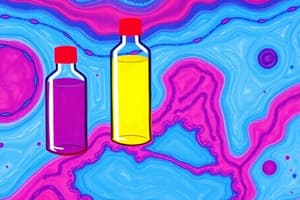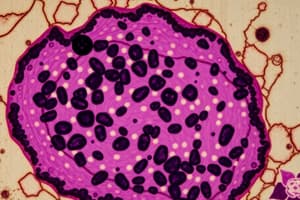Podcast
Questions and Answers
What is the purpose of fixation in tissue preservation?
What is the purpose of fixation in tissue preservation?
- To promote precipitation of formol-heme pigment
- To study the cross-linkage of proteins
- To study the autolysis process
- To preserve tissues permanently in as life-like a state as possible (correct)
Glutaraldehyde is good for immunohistochemical staining.
Glutaraldehyde is good for immunohistochemical staining.
False (B)
The standard solution of formaldehyde is ______________ neutral buffered formalin.
The standard solution of formaldehyde is ______________ neutral buffered formalin.
10%
Why is it important to carry out fixation as soon as possible after removal of the tissues?
Why is it important to carry out fixation as soon as possible after removal of the tissues?
What is the mechanism of action of aldehydes as fixatives?
What is the mechanism of action of aldehydes as fixatives?
Match the following fixatives with their characteristics:
Match the following fixatives with their characteristics:
Formaldehyde penetrates tissue poorly.
Formaldehyde penetrates tissue poorly.
The standard solution of glutaraldehyde is a ______________ buffered glutaraldehyde.
The standard solution of glutaraldehyde is a ______________ buffered glutaraldehyde.
What is the primary usage of methyl alcohol and ethyl alcohol in tissue fixation?
What is the primary usage of methyl alcohol and ethyl alcohol in tissue fixation?
Oxidizing agents are used frequently in tissue fixation.
Oxidizing agents are used frequently in tissue fixation.
What is the ideal pH range for fixation?
What is the ideal pH range for fixation?
Picric acid stains everything it touches ______________, including skin.
Picric acid stains everything it touches ______________, including skin.
Match the following fixatives with their characteristics:
Match the following fixatives with their characteristics:
What is the recommended ratio of fixative to tissue?
What is the recommended ratio of fixative to tissue?
Hypoxia of tissues raises the pH.
Hypoxia of tissues raises the pH.
What is the purpose of buffering capacity in the fixative?
What is the purpose of buffering capacity in the fixative?
Flashcards are hidden until you start studying
Study Notes
Fixation: Purpose and Importance
- The purpose of fixation is to preserve tissues in a life-like state as possible.
- Fixation should be carried out as soon as possible after tissue removal or death to prevent autolysis.
Types of Fixatives
-
Aldehydes:
- Include formaldehyde (formalin) and glutaraldehyde.
- Fix tissues by forming cross-linkages between proteins, particularly between lysine residues.
- Formaldehyde:
- Good for immunohistochemical techniques due to minimal protein structure harm.
- Penetrates tissue well, but is relatively slow.
- Standard solution: 10% neutral buffered formalin.
- Glutaraldehyde:
- Causes deformation of alpha-helix structure in proteins, making it poor for immunohistochemical staining.
- Fixes quickly, making it good for electron microscopy.
- Penetrates poorly, but gives best overall cytoplasmic and nuclear detail.
- Standard solution: 2% buffered glutaraldehyde.
-
Mercurials:
- Fix tissues by an unknown mechanism.
- Contain mercuric chloride and include B-5 and Zenker's fixatives.
- Penetrate relatively poorly, cause some tissue hardness, but are fast and give excellent nuclear detail.
- Best application: fixation of hematopoietic and reticuloendothelial tissues.
- Must be disposed of carefully due to mercury content.
-
Alcohols:
- Include methyl alcohol (methanol) and ethyl alcohol (ethanol).
- Are protein denaturants and not used routinely for tissues due to brittleness and hardness.
- Good for cytologic smears due to quick action and good nuclear detail.
-
Oxidizing Agents:
- Include permanganate fixatives (potassium permanganate), dichromate fixatives (potassium dichromate), and osmium tetroxide.
- Cross-link proteins, but cause extensive denaturation.
- Have specialized applications, but are used infrequently.
-
Picrates:
- Foremost among these is Bouin's solution.
- Has an unknown mechanism of action.
- Does almost as well as mercurials with nuclear detail, but does not cause as much hardness.
- Picric acid is an explosion hazard in dry form and stains skin and surfaces yellow.
Factors Affecting Fixation
- Fixation is best carried out close to neutral pH, in the range of 6-8.
- Hypoxia of tissues lowers pH, requiring buffering capacity in the fixative to prevent excessive acidity.
- Common buffers include phosphate, bicarbonate, cacodylate, and veronal.
- Penetration of tissues depends on fixative diffusability, with formalin and alcohol penetrating best, and glutaraldehyde worst.
- Sectioning tissues thinly (2-3 mm) helps with penetration.
- Volume of fixative is important, with a recommended 10:1 ratio of fixative to tissue.
Studying That Suits You
Use AI to generate personalized quizzes and flashcards to suit your learning preferences.




